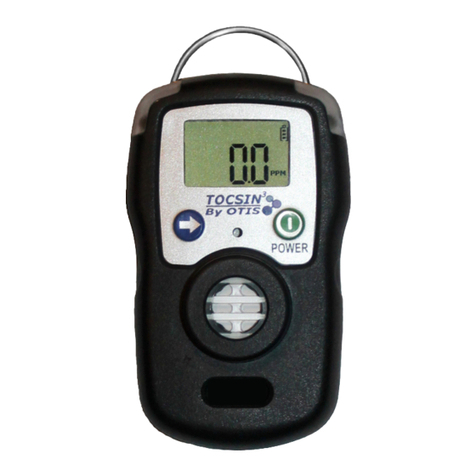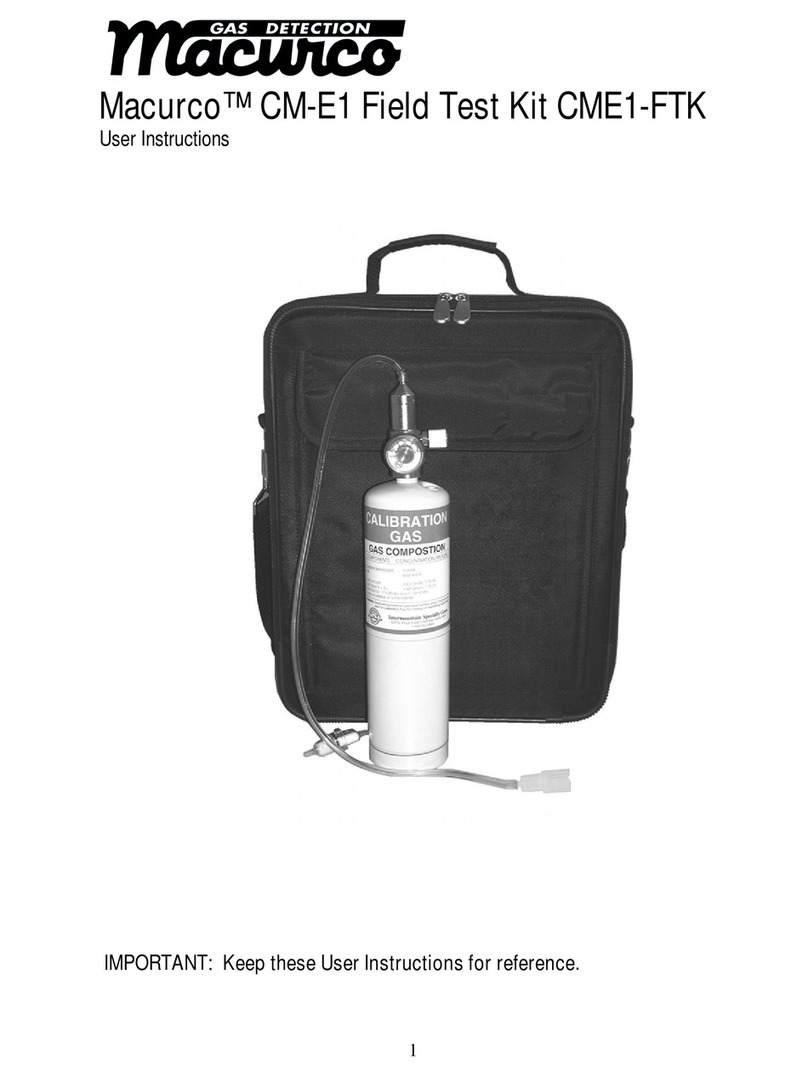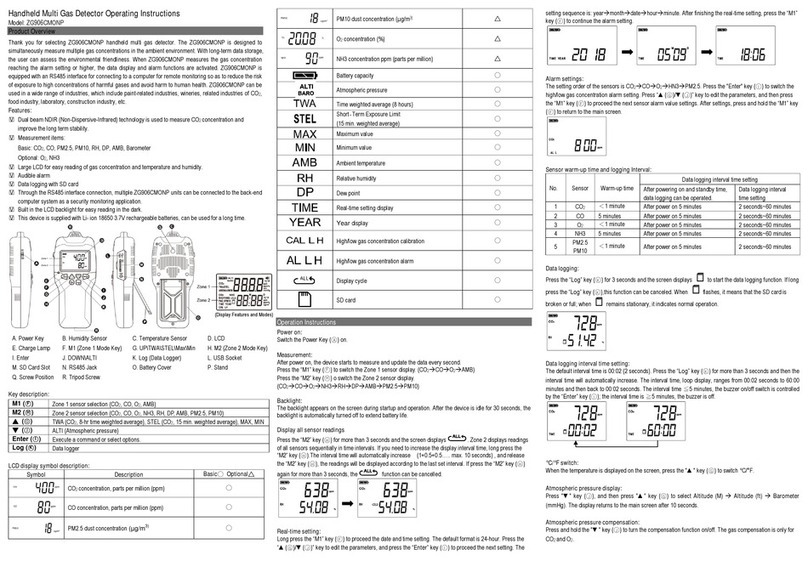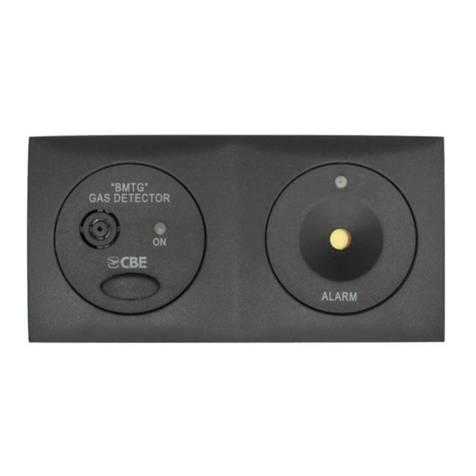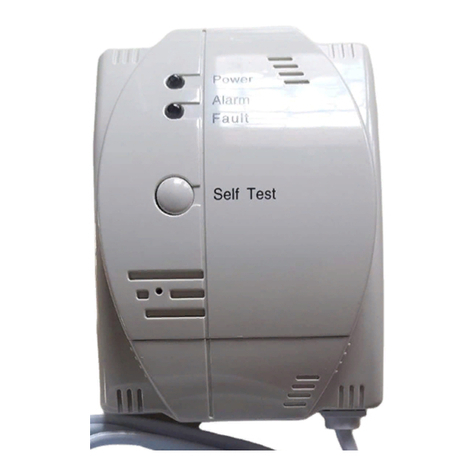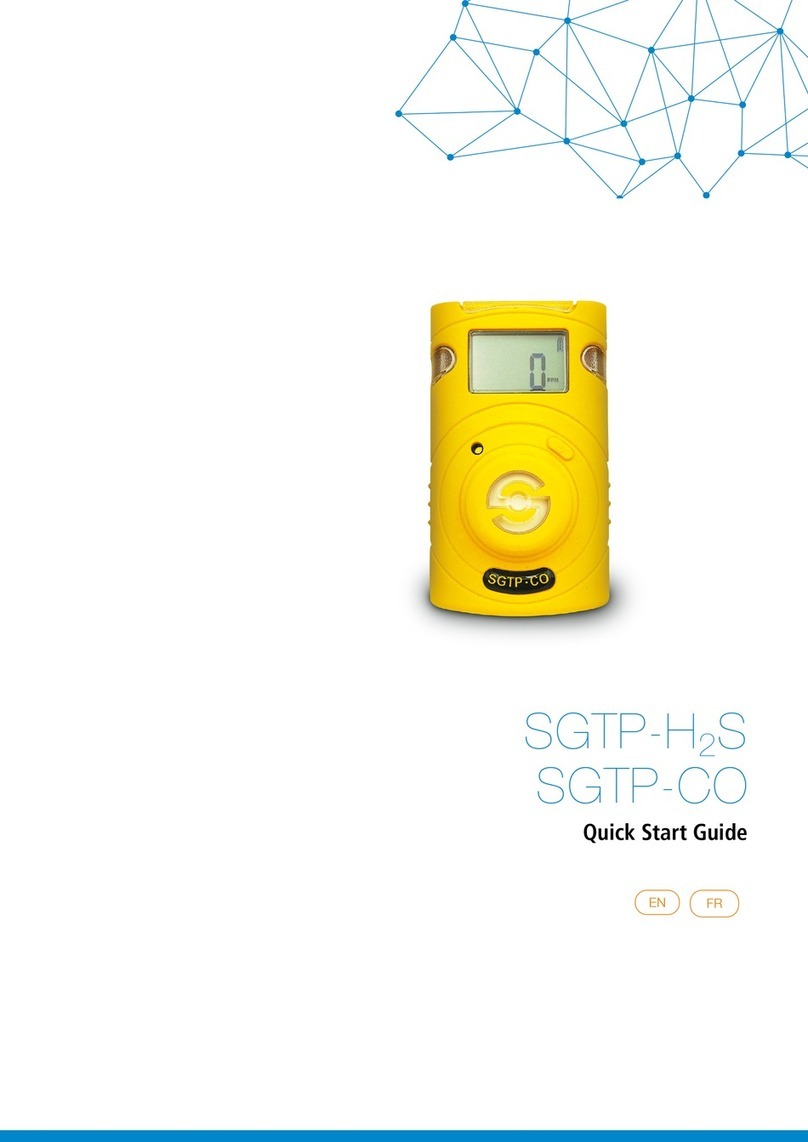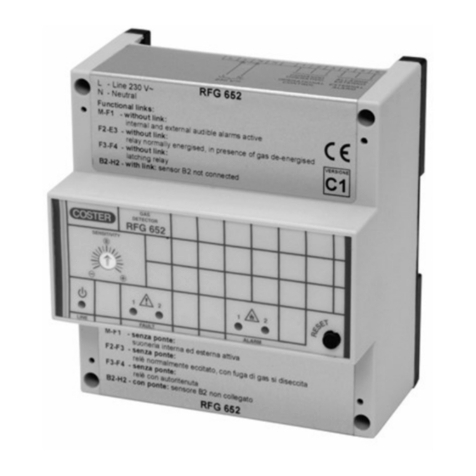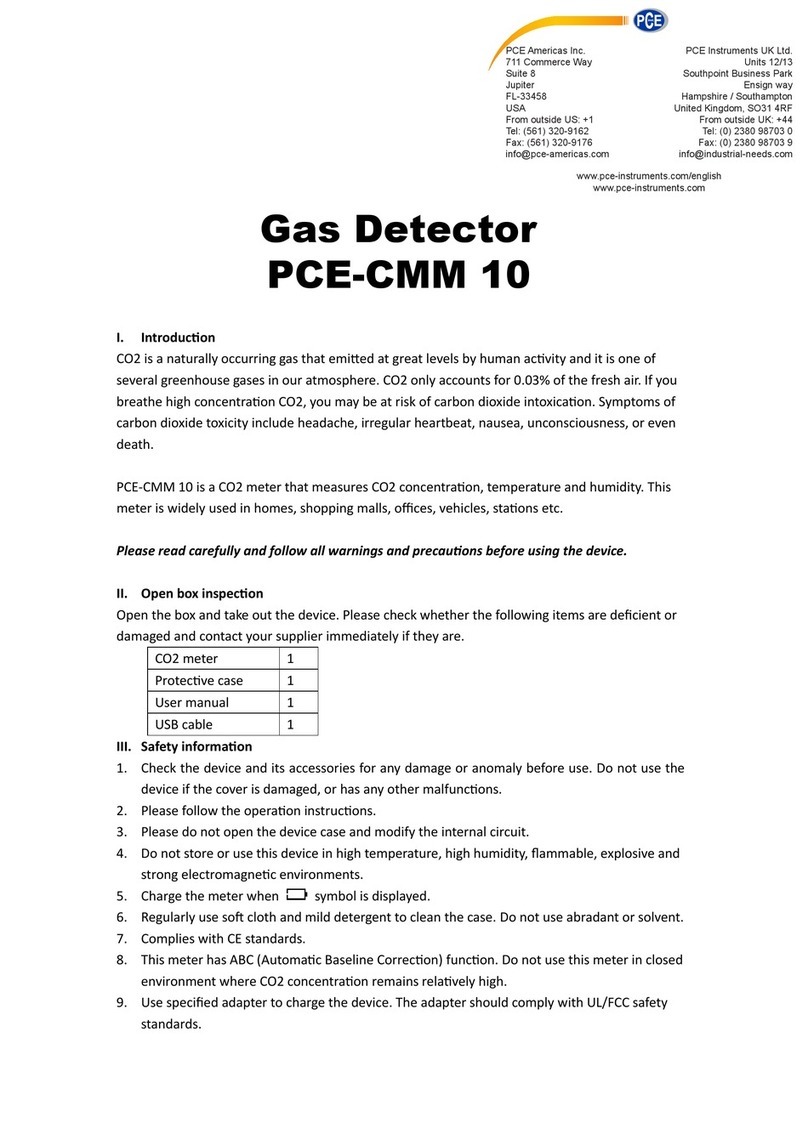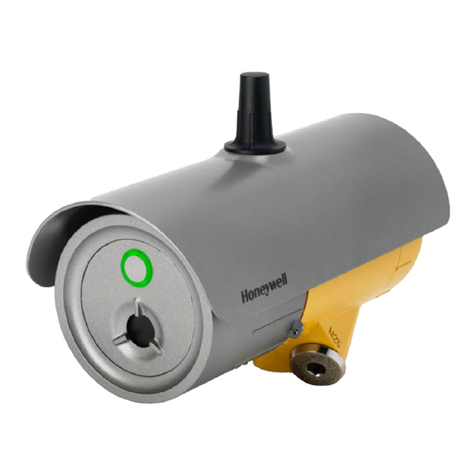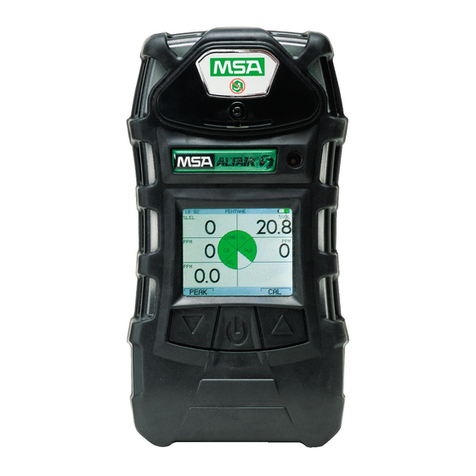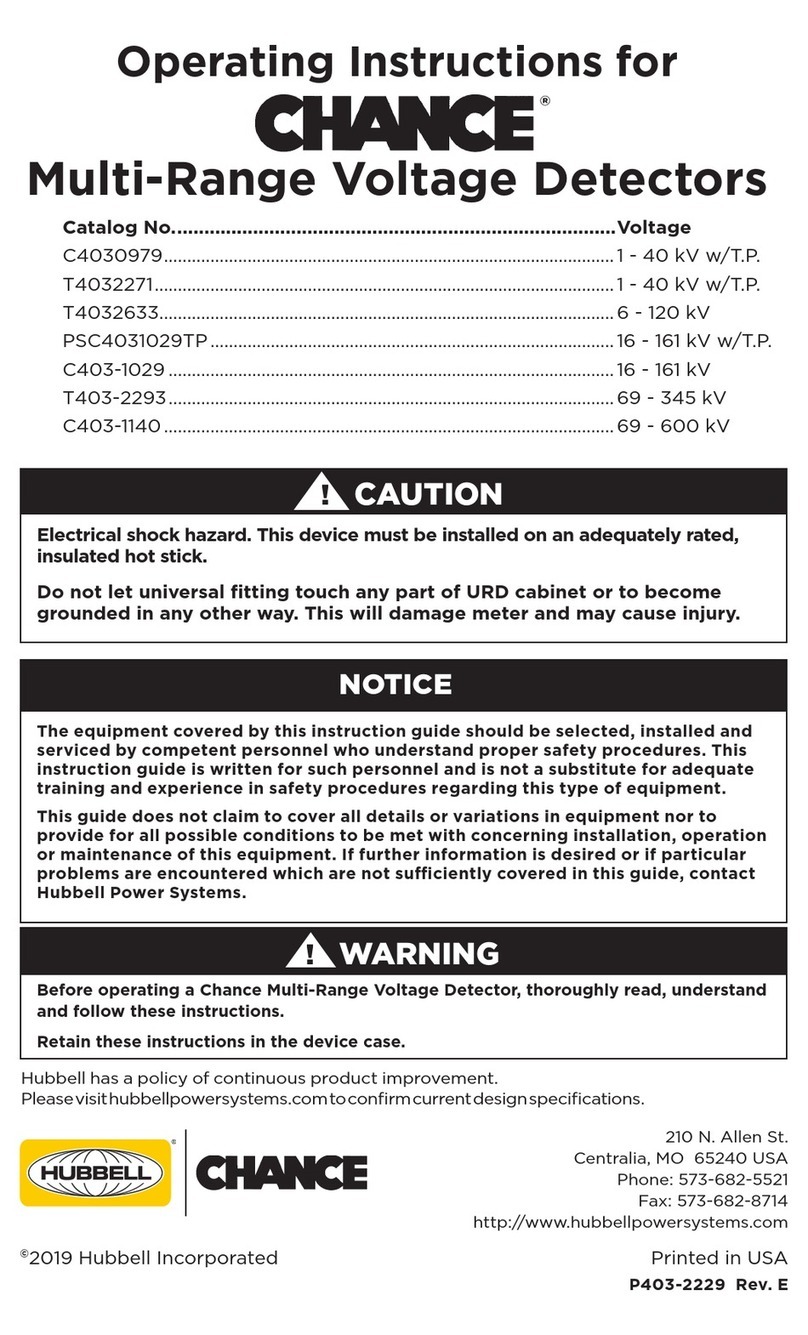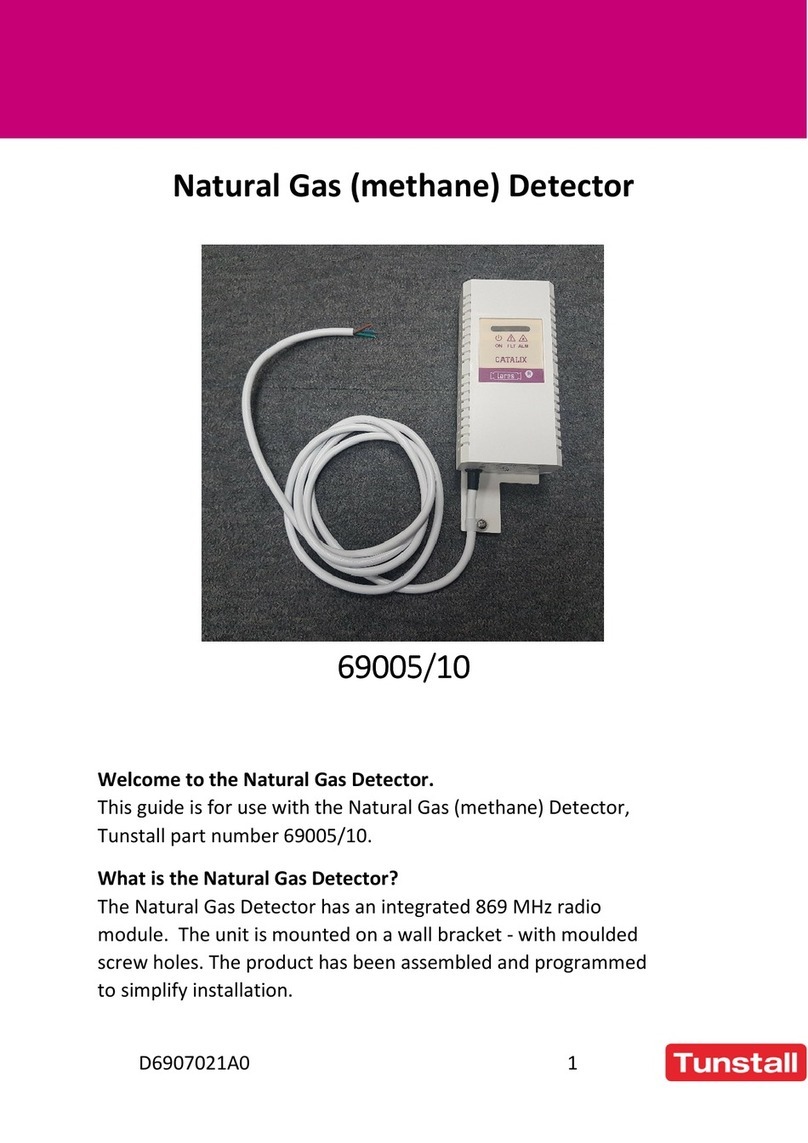OTIS OI-6000K NXP Series User manual



CAUTION
CAUTION: FOR SAFETY REASONS, THIS EQUIPMENT MUST BE OPERATED AND
SERVICED BY QUALIFIED PERSONNEL ONLY. READ AND UNDERSTAND THE
INSTRUCTION MANUAL COMPLETELY BEFORE OPERATING OR SERVICING.
DANGER
DANGER: OTIS INSTRUMENTS INC. OI-6000K-X-X-X-NXP-X IS AN AMBIENT AIR TOXIC
GAS SENSOR ASSEMBLY AND ONLY MONITORS IN THE IMMEDIATE VICINITY OF THE
SENSOR HOUSING. A SITE SURVEY IS REQUIRED IN ORDER TO DETERMINE THE
BEST PLACEMENT AND QUANTITY OF SENSOR ASSEMBLIES. IMPROPER
INSTALLATION CAN LEAD TO AN UNDETECTABLE GAS LEAK WHICH COULD RESULT
IN PERSONAL INJURY OR LOSS OF LIFE.
THE OI-600K-X-X-X-NXP-X IS NOT TO BE USED IN CLASSIFIED LOCATIONS.

TABLE OF CONTENTS
iOI-6000K-X-X-X-NXP-X OPS_GUIDE_REV 1.0
TABLE OF CONTENTS
1PRODUCT OVERVIEW..........................................................................................................................................1
1.1 INTRODUCTION ....................................................................................................................................................1
1.2 PRODUCT SPECIFICATIONS...............................................................................................................................2
1.3 SYSTEM DIAGRAMS ............................................................................................................................................3
1.3.1 EXTERNAL SYSTEM DIAGRAM...........................................................................................................................3
1.3.2 INTERNAL SYSTEM DIAGRAM............................................................................................................................4
1.3.3 ASSEMBLY DIAGRAM..........................................................................................................................................5
2INSTALLATION AND START-UP..........................................................................................................................6
2.1 PRODUCT PLACEMENT.......................................................................................................................................6
2.2 PRODUCT MOUNTING .........................................................................................................................................7
2.3 WIRING CONFIGURATIONS.................................................................................................................................7
2.3.1 OPENING THE ENCLOSURE................................................................................................................................8
2.3.2 CONNECTING POWER .........................................................................................................................................8
2.3.3 CONNECTING 4-20 MA OUTPUT .......................................................................................................................10
2.3.4 CONNECTING RS-485 ........................................................................................................................................11
2.3.5 CONNECTING RELAYS/ALARMS......................................................................................................................13
2.3.6 CONNECTING THE FAULT TERMINAL .............................................................................................................19
2.3.7 CLOSING THE ENCLOSURE..............................................................................................................................20
2.4 SYSTEM START-UP............................................................................................................................................20
2.5 NORMAL OPERATING MODE............................................................................................................................21
3PRODUCT SETTINGS AND CONFIGURATION .................................................................................................22
3.1 RELAY TEST .......................................................................................................................................................22
3.1.1 PERFORMING THE RELAY TEST......................................................................................................................23
3.2 SYSTEM INFORMATION.....................................................................................................................................23
3.3 NULL/CALIBRATION TIMER INFORMATION ....................................................................................................24
3.4 UNIT INFORMATION...........................................................................................................................................24
3.5 LATCHING AND NON-LATCHING RELAY SETTINGS......................................................................................25
3.5.1 RELAY 1: LATCHING/NON-LATCHING SETTING............................................................................................25
3.5.2 RELAY 2: LATCHING/NON-LATCHING SETTING............................................................................................26
3.6 RELAY FAIL-SAFE SETTING .............................................................................................................................26
3.6.1 RELAY 1: FAIL-SAFE SETTING ........................................................................................................................27
3.6.2 RELAY 2: FAIL-SAFE SETTING ........................................................................................................................27
3.7 FAULT TERMINAL FAIL-SAFE SETTING ..........................................................................................................28
3.7.1 FAULT TERMINAL: FAIL-SAFE SETTING.........................................................................................................28
3.8 CALIBRATION METHOD.....................................................................................................................................28
3.9 MODBUS ADDRESS SETTING...........................................................................................................................29
3.10 MODBUS BAUD SETTING..................................................................................................................................30
3.11 4-20 mA OFFSET SETTINGS..............................................................................................................................31
3.11.1 ZERO OFFSET SETTING ....................................................................................................................................31
3.11.2 FULL-SCALE OFFSET SETTING........................................................................................................................32
3.12 DISPLAY SCREEN CONTRAST SETTING.........................................................................................................32
3.13 RETURN TO FACTORY DEFAULT SETTINGS..................................................................................................33
3.14 RESET NULL & CALIBRATION VALUES ..........................................................................................................35

TABLE OF CONTENTS
OI-6000K-X-X-X-NXP-X OPS_GUIDE_REV 1.0 ii
4OPERATION SETTINGS .....................................................................................................................................36
4.1 POWERING THE DEVICE ...................................................................................................................................36
4.1.1 POWERING OFF..................................................................................................................................................36
4.1.2 POWERING ON ...................................................................................................................................................36
4.2 SENSOR CALIBRATION.....................................................................................................................................37
4.2.1 NULLING THE SENSOR (AUTO NULL) .............................................................................................................37
4.2.2 CALIBRATING THE SENSOR (MANUAL CAL)..................................................................................................39
4.2.3 CALIBRATING THE SENSOR (AUTO CAL).......................................................................................................40
4.3 SENSOR ALARM SETTINGS..............................................................................................................................42
4.3.1 SENSOR LOW ALARM SETTING.......................................................................................................................42
4.3.2 SENSOR LOW ALARM RISE/FALL SETTING ...................................................................................................43
4.3.3 SENSOR HIGH ALARM SETTING ......................................................................................................................43
4.3.4 SENSOR HIGH ALARM RISE/FALL SETTING...................................................................................................44
4.4 MANUAL RESET FOR ACTIVATED LATCHING ALARMS ...............................................................................44
5PRODUCT MAINTENANCE.................................................................................................................................45
5.1 SCHEDULED MAINTENANCE............................................................................................................................45
5.2 SENSOR REPLACEMENT ..................................................................................................................................46
5.3 PRODUCT TROUBLESHOOTING.......................................................................................................................48
5.4 PRODUCT REPLACEMENT PARTS AND ACCESSORIES...............................................................................49
APPENDIX A: INTRODUCTION TO 4-20 MA CURRENT LOOP SIGNALS ............................................................................51
APPENDIX B: MODBUS COMMUNICATIONS.........................................................................................................................53
APPENDIX C: MODBUS REGISTER MAP...............................................................................................................................55
APPENDIX D: PRODUCT WARRANTY STATEMENT.............................................................................................................57
APPENDIX E: INFORMATION ABOUT RMA SERVICE REPAIRS .........................................................................................59
APPENDIX F: INFORMATION ABOUT RMA RETURNS FOR CREDIT ..................................................................................61

PRODUCT OVERVIEW
1 OI-6000K-X-X-X-NXP-X OPS_GUIDE_REV 1.0
1PRODUCT OVERVIEW
1.1 INTRODUCTION
The Otis Instruments, Inc. (Otis) GEN II Model OI-6000K-X-X-X-NXP-X (OI-6000K) Non-Explosion-Proof
Ambient Air Toxic Gas Detector is designed to detect a wide range of toxic gases in many environments
excluding classified locations. The OI-6000K features a pre-mounted strobe light and dual tone horn. The
strobe light can be selected to be Red, Amber, Blue, or a Tri-Color (Green/Amber/Red) LED. The OI-6000
display screen will always show the present concentration of gas being detected by the sensor assembly.
This document is an operation manual containing diagrams and step-by-step instructions for the proper and
safe installation, start-up, configuration and settings, normal operation, and product maintenance of the OI-
6000K.
NOTICE
This document should be read in its entirety before the initial operation of the product.
Should a question arise during the use of the product, this document will serve as a first reference for the
end-user. For inquiries beyond the information and instructions provided within this manual, contact the
sales representative of this product for assistance.

PRODUCT OVERVIEW
OI-6000K-X-X-X-NXP-X OPS_GUIDE_REV 1.0 2
1.2 PRODUCT SPECIFICATIONS
System Specifications
Operating Voltage
+12 to +35 VDC
Current Draw
1.25 Amps Maximum
Operating Temperature Range
-20⁰C to +54⁰C
Humidity Range
0% to 98% Relative Humidity, Noncondensing
Measurement Range
Varies based on gas type
Response Time
Varies based on gas type
Protection
Power Electromagnetic Interference (EMI) Filter
4-20 mA Surge Suppression
RS-485 Modbus Surge Suppression
Display
Transflective (sunlight-readable)
102x64 LCD Screen
LED Back-Light
Interface
3 Push-Buttons (MENU, ADD, SUB)
LOW and HIGH Alarm Indicator LEDs
Outputs
Wired (Analog)
4-20 mA (3-Wire)
Wired (Digital)
RS-485 Modbus RTU
Relays
Two Dry Contact Relays, Pre-wired to Strobe Light and Horn
Mechanical Specifications
Enclosure Materials
Fiberglass Device Enclosure with Clear Plastic Lid
Sensor Housing Materials
Black Polypropylene Plastic with Stainless Steel Mesh Screen
Product Dimensions
16.74" T x 10.06" W x 4.31" D
Product Weight

PRODUCT OVERVIEW
3 OI-6000K-X-X-X-NXP-X OPS_GUIDE_REV 1.0
1.3 SYSTEM DIAGRAMS
Refer to the following diagrams for identification of the external and internal system components that may
be referred to in this manual.
1.3.1 EXTERNAL SYSTEM DIAGRAM
1Strobe Light
2Mounting Foot (4X)
3Enclosure Latch (2X)
4Front Panel Thumb Screw
(2X)
5SUB Button
6Sensor Housing Assembly
7LOW and HIGH LED
Indicators
8Dual-Tone Horn
9Optional AC Power Cord
10 ADD Button
11 MENU Button
12 LCD Display Screen
13 Calibration Adapter Kit
(Sold Separately)
⑬

PRODUCT OVERVIEW
OI-6000K-X-X-X-NXP-X OPS_GUIDE_REV 1.0 4
1.3.2 INTERNAL SYSTEM DIAGRAM
1RS-485 Modbus Terminal Block
2Fault Terminal Block
3Power Input/4-20mA Output Terminal Block
4Optional AC Power Supply
5Digital Sensor Board Cable and Connector
6Sensor Housing Interface Board
7Sensor Interface Adapter Board
8Wiring Terminal Block
9Relay 1 Terminal Block
10 Relay 2 Terminal Block
11 Digital Sensor Board Socket

PRODUCT OVERVIEW
5 OI-6000K-X-X-X-NXP-X OPS_GUIDE_REV 1.0
1.3.3 ASSEMBLY DIAGRAM
1Strobe Light
2Enclosure Base
3Sensor Housing Base
4Sensor Element
5Sensor Housing Cap
6Electronics Assembly
7Gas Type Label
8Faceplate Assembly
9Enclosure Lid

INSTALLATION AND STARTUP
OI-6000K-X-X-X-NXP-X OPS_GUIDE_REV 1.0 6
2INSTALLATION AND START-UP
2.1 PRODUCT PLACEMENT
The installation instructions, and any other information supplied by Otis, provide only basic guidelines
relating to the properties of toxic gas and the effects of environmental conditions on the OI-6000K device.
Sensor placement should be determined in consultation with the site safety personnel, as well as those
knowledgeable of: (1) the site/facility where the equipment is being installed and (2) the potentially present
gas types and their dispersion. Otis strongly recommends that the end-user consults with the appropriate
third-party Health, Safety and Environmental (HSE) and Industrial Hygiene (IH) professionals to determine
the final quantity and placement of your gas detection devices.
The primary purpose of the OI-6000K is to provide an early warning of the accumulation of toxic gas, in order
to minimize hazards to people and property. Proper placement of the device is paramount to achieving this
goal.
The following general guidelines should be considered when determining the placement of the OI-6000K:
◼The unit shall NOT be placed in an environment that is classified.
◼The unit shall be placed such that the position of the sensor housing is pointing downward to the
ground.
◼Avoid installing the unit in a location where airborne particles could cover or coat the sensor head.
◼The unit should be placed in an area that will produce the highest gas concentration. Enclosed corners
and stopping points of moving devices are two areas susceptible to a buildup of toxic gas.
◼In order to provide an accurate representative sample of a room, care should be taken to avoid locating
the unit near a room entrance, fresh air intake vent, or vehicle/generator exhaust point.
◼The unit should be placed as close as physically possible to the source of the potential toxic gas leak.
◼In consideration of possible ignition points, the unit should be placed between the potential leak
source and ignition point.
◼Consider placing the unit in a seldom used area, such as a warehouse, storage area, or other
unfrequented location.
◼Consider accessibility for regular calibration and other required maintenance.
◼When monitoring a ventilated gas cylinder storage area, the unit should be placed near the air return
vent.
◼When monitoring an outdoor or open-air area, the unit should be placed near the air intake of the
HVAC system of the building.
◼When monitoring for the potential presence of multiple toxic gas types, the unit should be calibrated
for the least cross-sensitive toxic gas.
NOTICE
These guidelines are ONLY intended as a general directive for the placement of the OI-6000K. This
information should NOT serve as a complete list when considering all potential parameters for the proper
location of the unit. It is STRONGLY advised that a third party Certified Industrial Hygienist, or other
Certified Safety Professional, conduct a site survey and annotate the location and quantity of detection
devices that should be installed for EVERY installation of EVERY site.

INSTALLATION AND STARTUP
7 OI-6000K-X-X-X-NXP-X OPS_GUIDE_REV 1.0
2.2 PRODUCT MOUNTING
It is recommended to mount the unit to a solid structure (such as a concrete wall, steel column, or angle
iron) where a minimum of vibration will be transmitted to the unit. Alternately, a pole may be used along
with a strap or a U-bolt, as long as it is rigid and of sufficient strength. Wooden structures are not
recommended for mounting, as they trap moisture (which could affect sensor performance) and their
mounting rigidity degrades over time (screws/bolts weaken and fall out or corrode).
Any style of bolt or screw may be used as long as it is steel and meets or exceeds the following:
◼Maximum ¼"-20 bolt or ؼ" screw (length varies with user need)
◼Flat washers for bolts/nuts/screws
◼Minimum Grade 5 (or better)
◼Corrosion protection for all hardware (paint, galvanize, zinc plating, etc.)
2.3 WIRING CONFIGURATIONS
The OI-6000K has several basic wiring configurations, dependent upon the desired usage and functionality
intended by the end-user. All OI-6000K units require +12 to +35 Volts of wired DC power to operate. Data
communication from the device, through either the 4-20 output or the RS-485 Modbus connection, to an
external location are optional. Consult the subsequent sections of wiring instructions for pertinent
information and guidelines pertaining to the installation of your device.
CAUTION
VERIFY that the power source is disabled before beginning the following wiring steps or performing
any maintenance inside the device enclosure.
The internal components can be static sensitive. Use caution when opening the enclosure and
handling internal components.
DO NOT use any metal objects or tools to remove the terminal board from the internal system.
VERIFY that the label and color combination of the control board terminal exactly matches the
corresponding label and color combination of the power terminal.
OI-6000K Terminal Block Wire Gauges
Terminal Block
Wire Gauge
Power Terminal
Relay 1 & 2
Terminal
Min: 26 AWG
Max: 14 AWG
Modbus Terminal
Fault Terminal
Min: 26 AWG
Max: 16 AWG
AWG: American Wire Gauge

INSTALLATION AND STARTUP
OI-6000K-X-X-X-NXP-X OPS_GUIDE_REV 1.0 8
2.3.1 OPENING THE ENCLOSURE
To prepare the OI-6000K for installation, you must first open the device, exposing the control
board and its components for wiring.
1. Open the enclosure lid by unlatching the right-side enclosure latches.
2. Using your thumb and forefinger, loosen the front panel thumbscrews that secure the
faceplate and electronics assembly to the enclosure.
3. Open the faceplate to expose the internals of the electronics which allows access to the
wiring terminals.
NOTICE
Disconnecting the sensor connector plug from the digital sensor board will allow for the
faceplate and electronics assembly to swing open further. Disconnecting the digital sensor
board may provide ease in accessing the control board terminals for wiring. If this step is
performed, it is essential that all connections are rejoined before securing the faceplate and
electronics assembly back to the enclosure.
2.3.2 CONNECTING POWER
The AC model OI-6000K comes with a standard power cord that is plugged into a regular wall
outlet, you may skip the below DC wiring instructions and advance to the 4-20 wiring if that
functionality is desired. To provide DC power to the OI-6000K, you will need to connect the power
cable from the sensor terminal block on an Otis monitor, or alternate user supplied power source,
to the OI-6000K power terminal block located on the backplane of the enclosure. An electrician
will need to install the proper cord grip for the cabling being used. Refer to the following
instructions for how to wire your device:
On the GEN II Model OI-6000K Detector:
1. Feed the power wires through the electrician installed cord grip and into the enclosure.
2. Locate the power terminal block on the backplane and complete the following:
a. Connect the positive supply (RED) wire to the screw terminal opposite the
preinstalled RED wire on the terminal block that connects to the back of the control
board.
b. Connect the ground (BLACK) wire to the screw terminal opposite the preinstalled
BLACK wire on the terminal block that connects to the back of the control board.

INSTALLATION AND STARTUP
9 OI-6000K-X-X-X-NXP-X OPS_GUIDE_REV 1.0
CUSTOMER POWER
SUPPLY WIRING
OI-6000K
BACKPLANE TERMINAL BLOCK
+12 to +35 VDC
RED
+12 to +35 VDC
RED
GND
BLACK
GND
BLACK
4-20 mA
4-20 mA
NOTICE
Wiring power to the device is the ONLY requirement for the OI-6000K to operate. With the
provision of power, the unit will function normally, indicating the presence of toxic gas at the
sensor and providing the gas level reading on the display screen. To utilize the added
functionality of the device, additional wiring is necessary. If an Otis Monitor is not used, the OI-
6000K can be powered from any +12 to +35 VDC power supply that can supply at least 1.250
Amps.

INSTALLATION AND STARTUP
OI-6000K-X-X-X-NXP-X OPS_GUIDE_REV 1.0 10
2.3.3 CONNECTING 4-20 MA OUTPUT
To utilize the 4-20 mA wired analog output feature of the OI-6000K, you will need to connect the
signal cable from your monitoring device to the OI-6000K terminal block located on the backplane
as well as a common ground reference wire. Refer to the following instructions for how to wire
your device:
On the GEN II Model OI-6000K Detector:
1. Feed the signal wire through the electrician installed cord grip and into the enclosure.
NOTICE
The power and signal wires may be conjoined as a 3-wire cable, incorporating the power (RED),
ground (BLACK), and signal (GREEN) wires all into one jacketed cable.
2. Locate the terminal block on the backplane and complete the following:
a. Connect the signal (GREEN) wire to the “4-20 mA” terminal.
b. Connect the common ground reference wire to the DC power source ground terminal.
CUSTOMER
MONITORING DEVICE
OI-6000K
BACKPLANE TERMINAL BLOCK
4-20 mA
GREEN
4-20 mA
GREEN
Ground
BLACK
Ground
BLACK

INSTALLATION AND STARTUP
11 OI-6000K-X-X-X-NXP-X OPS_GUIDE_REV 1.0
2.3.4 CONNECTING RS-485
The OI-6000K supports Modbus RTU over a RS-485 link. To integrate your device with RS-485
Modbus data communications, you will need to connect the Modbus cable from your Otis Monitor
RS-485 input terminal block to the OI-6000 RS-485 output terminal block located on the control
board of the unit. Refer to the following instructions for how to wire your device:
On the GEN II Model OI-6000K Detector:
1. Feed the RS-485 cable through a cord grip and into the enclosure.
2. Locate the RS-485 output terminal block on the control board and complete the following:
a. Connect the RS-485 B (BROWN) wire to the “B” terminal.
b. Connect the ground (WHITE) wire to the “GND” terminal.
c. Connect the RS-485 A (YELLOW) wire to the “A” terminal.
On the Otis Monitor:
1. Feed the RS-485 cable through a cord grip and into the enclosure.
2. Locate the RS-485 input terminal block on the control board and complete the following:
a. Connect the RS-485 B (BROWN) wire to the “B” terminal.
b. Connect the ground (WHITE) wire to the “GND” terminal.
c. Connect the RS-485 A (YELLOW) wire to the “A” terminal.

INSTALLATION AND STARTUP
OI-6000K-X-X-X-NXP-X OPS_GUIDE_REV 1.0 12
OTIS MONITOR
RS-485 TERMINAL
OI-6000K
RS-485 TERMINAL
A
YELLOW
A
YELLOW
GND
WHITE
GND
WHITE
B
BROWN
B
BROWN
NOTICE
If an Otis Monitor is not used, the OI-6000K can be connected to a Programmable Logic
Controller (PLC) for RS-485 Modbus data communications. For integration and setup, refer to
the Modbus Register Map found in Appendix C of this manual.

INSTALLATION AND STARTUP
13 OI-6000K-X-X-X-NXP-X OPS_GUIDE_REV 1.0
2.3.5 CONNECTING RELAYS/ALARMS
The OI-6000K relays are used to power and control the included strobe light and dual-tone horn.
The strobe light and dual-tone horn are prewired from the factory and require no wiring by the
end user. The following instructions are for reference if the strobe light or dual-tone horn need to
be replaced in the field. The first section details wiring the single color, OI-481-X, strobe to the
relays. The second and third sections detail connecting the tri-color, OI-481-RGA, strobe to the
relays in non-O2and O2configurations.
2.3.5.1 CONNECTING OI-481-R/OI-481-A/OI-481-B STROBE LIGHT AND OI-488 HORN
On the OI-6000K Detector:
1. Locate the wiring terminal block on the backplane of the enclosure and complete the
following:
a. Connect a RED jumper wire to the positive supply terminal.
b. Connect the BLACK wire from the OI-481-X to the negative supply terminal.
c. Connect the BLACK wire from the OI-488 to the negative supply terminal as well.
2. Locate the Relay 1 terminal block on the radio/relay board and complete the following:
a. Connect a BLUE jumper wire to the “COM” terminal.
b. Connect the RED wire from the OI-481-X to the “NO” terminal.
3. Locate the Relay 2 terminal block on the radio/relay board and complete the following:
a. Connect the RED jumper to the “COM” terminal.
b. Connect the BLUE jumper to the “COM” terminal as well.
c. Connect the RED wire from the OI-488 to the “NO” terminal.
NOTICE
Relays are protected by replaceable 4 Amp fuses.
The two protective fuses must only be replaced with OI-FUSE-4A-250.

INSTALLATION AND STARTUP
OI-6000K-X-X-X-NXP-X OPS_GUIDE_REV 1.0 14
CONNECTING OI-481-R/OI-481-A/OI-481-B STROBE LIGHT AND OI-488 HORN
BACKPLANE WIRING
TERMINAL BLOCK
OI-6000K
RELAY 1 TERMINAL
OI-6000K
RELAY 2 TERMINAL
NEGATIVE
OI-481-X BLACK WIRE
NC
NC
OI-488 BLACK WIRE
POSITIVE
RED
NO
OI-481-X RED WIRE
NO
OI-488 RED WIRE
COM
BLUE
COM
BLUE
RED

INSTALLATION AND STARTUP
15 OI-6000K-X-X-X-NXP-X OPS_GUIDE_REV 1.0
2.3.5.2 CONNECTING OI-481-RGA STROBE LIGHT AND OI-488 HORN –NON-O2 SENSORS
On the OI-6000K Detector:
1. Locate the wiring terminal block on the backplane of the enclosure and complete the
following:
a. Connect a RED jumper wire to the positive supply terminal.
b. Connect the BLACK wire from the OI-481-RGA to the negative supply terminal.
c. Connect the BLACK wire from the OI-488 to the negative supply terminal as well.
2. Locate the Relay 1 terminal block on the radio/relay board and complete the following:
a. Connect a BLUE jumper wire to the “COM” terminal.
b. Connect the YELLOW wire from the OI-481-RGA to the “NO” terminal.
c. Connect the GREEN & BLUE wire from the OI-481-RGA to the “NC” terminal.
3. Locate the Relay 2 terminal block on the radio/relay board and complete the following:
a. Connect the RED jumper to the “COM” terminal.
b. Connect the BLUE jumper to the “COM” terminal as well.
c. Connect the RED wire from the OI-481-X to the “NO” terminal.
d. Connect the RED wire from the OI-488 to the “NO” terminal as well.
Table of contents
Other OTIS Gas Detector manuals
